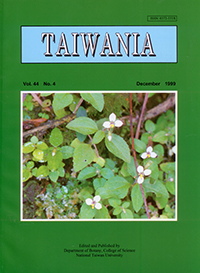Research Paper
Eastern Asia as a Living Museum for Archaic Angiosperms and Other Seed Plants
Robert F. Thorne
Published on: December 1999
Page: 413 - 422
DOI: 10.6165/tai.1999.44(4).413
Abstract
Asia, even excluding Malaysia, has the richest family and subfamily flora of angiosperms in the world, 478 of 755 total families and additional subfamilies recognized in my system of classification. Eastern and southeastern Asia are especially rich in conifers (6 of 7 families plus Agathis of the seventh family, Araucariaceae, in Malaya) and those angiospermous families and subfamilies retaining many primitive features, 27 of 41 families of Magnoliidae (Magnolianae, Nymphaeanae, and Rafflesianae) and Ranunculidae (Ranunculanae) (with 7 more families in Malesia and northeastern Australia that might have migrated from southeastern Asia since the junction of the Asiatic and Australian tectonic plates, possibly 15 million years before the present). Also represented in eastern and southeastern Asia are 9 of 9 families and additional subfamilies of Hamamelidales (Rosidae) and 26 of 32 families of Alismatidae (Triuridanae, Acoranae, Aranae, Alismatanae), and Liliales (Liliidae), which seem to be the least specialized monocots. The much studied close floristic relationships between eastern Asia and eastern North America were much stronger in Cretaceous and Tertiary time. Indeed, many of the archaic genera of seed plants now restricted to eastern Asia once were widely distributed in North America and other parts of the northern hemisphere. Hence, one can state that eastern and southeastern Asia are indeed a living museum of archaic vascular plants, but fossil evidence is presently inadequate to prove that the region is the major birthplace of the conifers and flowering plants. It is probable, however, that some of the gymnosperms and archaic angiosperms did evolve in eastern and southeastern Asia, and especially in the Sino-Japanese Region.
中文摘要
即使不含馬來西亞,亞洲仍然是世界上具有最多的被子植物科及亞科的地區,在本人的分類系統中(全部計755科及亞科),有478科及亞科分佈於亞洲。特別是東亞及東南亞地區含有最多的裸子植物(在馬來半島就有裸子植物7科中的6科,以及第7南洋杉科的貝殼杉屬)以及保留許多原始特徵的被子植物如木蘭亞綱(木蘭,睡蓮及大花草超目“介於亞綱及目之間的類階”)及毛茛亞綱(毛茛超目)41科中的27科(另有亞洲及澳洲共有的7科可能在一千五百萬年前當亞洲及澳洲板塊仍然相連時自東南亞傳播至澳洲東北部)。另外東亞及東南亞還包含金縷梅目(薔薇亞綱)絕大部份的科及亞科,以及最原始的單子葉植物如(霉草、菖蒲、天南星及澤瀉超目)32科中的26科,及百合目(百合亞綱)。另外經常被研究的東亞及北美東部的植物相關係以在白堊紀及第三紀期間最為密切,許多目前侷限於東亞的古老種子植物屬在過去曾經廣泛分佈於北美及其他北半球區域,因此東亞及東南亞可說是古老維管束植物的現存博物館。但就目前收集到的化石而言,仍不足以證明本區是裸子植物及被子植物的故鄉。雖然如此,極可能某些裸子植物及古老的被子植物確實是在東亞(特別是中國及日本區域)及東南亞演化及孕育出來。 關鍵詞: 古老種子植物, 松柏類植物,木蘭亞綱,毛茛亞綱,澤瀉亞綱,百合目,亞洲作為現存博物館。
Keyword: Archaic seed plants, Conifers, Magnoliidae, Ranunculidae, Alismatidae, Liliales, Asia as living museum.


